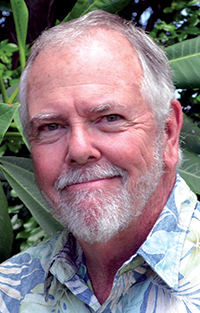KAILUA-KONA — As Hawaii County dengue cases approach 100, a top CDC official is set to arrive on island next week to assess the handling of the outbreak here.
Lyle Petersen, director of the CDC’s Division of Vector-Borne Diseases, will vet containment efforts and share his analysis with county and state officials during his visit, confirmed Gov. David Ige’s communications director Cindy McMillan.
“(Petersen) will evaluate ongoing efforts based on his visit and analysis of the most current data being captured on a daily basis,” McMillan said.
County officials and the state Department of Health requested the consultation, McMillan said. Further information was not available. Petersen directed questions about his visit back to the DOH, which passed them on to Hawaii County.
Petersen will arrive Tuesday and stay until Thursday, said Ilihia Gionson, executive assistant to Mayor Billy Kenoi.
“We’ll welcome him to the Emergency Operations Center so he can get an overview of what we are doing here,” Gionson said. “Other than that, he’ll pretty much go where he wants to.”
Kona Sen. Josh Green has pressed for greater CDC involvement and a more vigorous response in sometimes thorny exchanges with the DOH. The DOH has been in consultation with the federal agency during the outbreak, but Green called for a CDC team to be deployed here.
“I’m hoping (Petersen) can assess the full scope of the dengue infections on the Big Island and confirm we have the right comprehensive plan to prevent further spread,” Green said. “I also hope (he) can provide contingency plans should the outbreak accelerate.”
Naalehu Rep. Richard Creagan, a retired physician, has been trying to raise awareness that pregnant women infected with dengue might pass the infection on to their unborn child and that the disease increases the risk of miscarriage. On Tuesday, Creagan broke with county officials who have avoided giving the impression the island is not safe to visit.
“If someone is in the early stages of their pregnancy, they probably shouldn’t come to the Big Island at all,” Creagan said. “For the ones that are here, a lot of pregnant women don’t want to spread DEET around. They need to know what they can use and how they can protect themselves.”
County officials stress by taking proper precautions such as wearing repellent and avoiding high-mosquito areas, a visit to the Big Island remains safe and enjoyable.
The CDC urges pregnant women to be especially vigilant in protecting themselves from dengue. Besides wearing long clothes and avoiding high-mosquito areas, pregnant women should use repellents with 50 percent DEET, oil of lemon eucalyptus or other repellents. Babies, especially between ages 4 months to 1 year, are especially vulnerable to the fever and extra precautions should be taken with them, according to the CDC.
The dengue virus is transmissible after the first symptoms appear, and patients usually remain infectious for four to five days, and up to 12 days on the outside, according to the World Health Organization. The incubation period is four to 10 days after being bitten by an infected mosquito, and symptoms — which include rash, fever, pain behind the eyes and joint pain — usually last two to seven days, according to the WHO.
Dengue — the fastest growing tropical disease — now is endemic in 100 countries, and sickens about 100 million people each year and kills about 22,000.
Hawaii County Civil Defense and the DOH added a new round of informational meetings about the disease. They are:
• 6 p.m. Friday (Nov. 27) at the Ocean View Community Center.
• 6 p.m. Monday (Nov. 30) at the Waimea Middle School cafeteria.
• 6:30 p.m. Tuesday (Dec. 1) at the Kohala High School cafeteria.
• 6:30 p.m. Dec. 3 at the Pahoa High School cafeteria.
Email Bret Yager at byager@westhawaiitoday.com.








